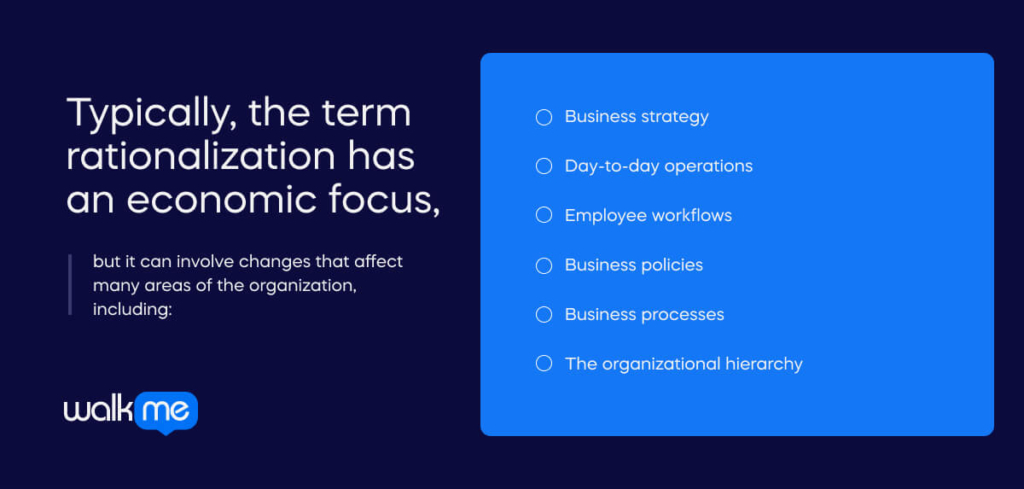What does rationalization mean in a business context?
The term “rationalization” is often used to refer to the act of “logically explaining a decision.” A manager who chooses to terminate an employee, for instance, will justify – or rationalize – that decision with a logical explanation.
Another usage of this term, which many of us may be less familiar with, is related to reorganization and restructuring in business.
Below, we’ll explore this meaning of the term, how rationalization differs from other organizational change processes, and more.
What Is Rationalization in Business?
Rationalization means restructuring an organization to improve efficiency.
One purpose of rationalization is to reduce complexity, which tends to increase over time.
As an organization grows, for instance, complexity will naturally increase in areas such as:
- Business processes
- The workplace
- Digital ecosystems
- The supply chain
- The organization’s structure
When complexity grows to the point where it hinders operational efficiency, rationalization is often called for.

Typically, the term rationalization has an economic focus, but it can involve changes that affect many areas of the organization, including:
- Business strategy
- Day-to-day operations
- Employee workflows
- Business policies
- Business processes
- The organizational hierarchy
Ultimately, the process of rationalization can improve organizational efficiency, organizational effectiveness, and its bottom line.
Here are a few examples of rationalization to illustrate what rationalization looks like in the real world:
- Asset rationalization is designed to reorganize an organization’s resources to improve efficiency and increase profits by, for instance, divesting less profitable assets, cutting costs, and reevaluate financing
- Product line rationalization aims to improve the profitability of its products by focusing on the products that deliver the most profit to the bottom line
- Market rationalization refers to rationalizing and redesigning the company’s interaction with markets and supply chains
The key takeaway here is that rationalization is about improving efficiency and profits through reorganization – also, as we’ll see below, the term “rationalization” tends to be used only within certain business domains.
Rationalization vs. Reorganization: Key Differences
Rationalization is a concept that tends to be used more frequently in economics and finance than in other areas of business. When discussing organizational changes aimed at improving business efficiency, other terms are more commonly used.
A few of these include:
- Restructuring
- Reorganization
- Reconfiguration
- Organizational change
- Organizational transformation
Each of these terms falls under the business discipline of change management, a field that focuses on executing, managing, and streamlining business changes.
Typically, organizational changes have been viewed as discrete change projects that occur only occasionally – they are implemented and then they finished.
In recent years, however, disruptive changes such as digital innovation have compelled many companies to undergo continual change. As a result, a number of companies have chosen to permanently embed change management functions into their operating model.
Agile is one example of a business approach that focuses on continual improvement and adaptation. When combined with the discipline of change management, agile practices can enable an organization to stay relevant, effective, and profitable.
When Are Rationalization and Reorganization Necessary?
There are a number of situations that can bring about the need to reorganize or rationalize.
Examples include:
- Misalignment with the marketplace or customer expectations
- Crises, such as the COVID-19 pandemic
- Supply chain complexity
- Obsolete and bloated IT systems
- Disruptive innovation
Each of the problems listed here will have a different impact on the organization. The solution to each one, therefore, should depend on the circumstances.
When deciding on the organizational change that best suits the situation, it is important to keep a few points in mind:
- Rationalization is a process that focuses on financial efficiency, and it often includes cost-cutting measures, so it is not always the right solution for every situation
- Reorganization – as it is used in the change management world – emphasizes the restructuring of business units or of changing the organization’s structural archetype, rather than cost-cutting
- Both of these types of changes tend to imply rather substantial organizational changes, which will often ripple out and impact other areas of the business
Importantly, regardless of which type of change is implemented, structured change management can be a useful discipline to study and implement, as we’ll see next.
The Importance of Managing Organizational Change

Change management is the business discipline dedicated to designing, managing, and leading organizational change projects.
While rationalization is less discussed than other types of change, the discipline of change management can still be valuable – in fact, it may be essential.
Properly executed change management, after all, can:
- Increase the chances of a change project’s success
- Decrease inefficiencies, errors, and mistakes
- Boost employee productivity, engagement, and performance
- Improve the overall outcomes of the project
Regardless of who is leading the project and what its purpose is, it is a good idea to work with experienced change managers to ensure its success. For more information on change management, it can be helpful to learn about the types of organizational change, change management theories, and change management best practices.
